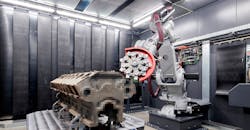Robot-Powered, High-Tech Fettling and Grinding
The FILL MACHINE ENGINEERING Grind Performer F automated work cell for high-tech fettling and grinding is operated by an industrial robot to simplify finishing of iron castings. Thanks to an automated tool-replacement system, it can carry out the various operations fully automatically, whether deburring small iron castings or massive ones. In addition to time savings in machining, the Grind Performer F ensures flexibility, high quality, and reproducibility of the machining operations. Another benefit of the system is a substantial improvement in working conditions.
“With development of the Grind Performer F, we have brought the world of iron casting into the modern age,” explained Thomas Rathner, head of the Casting Technology Competence Center at Fill. “Machining iron castings of any size was previously back-breaking, manual work in the most difficult working conditions. Thanks to state-of-the-art technology it has been elevated to a new, contemporary level. Day-to-day work in machining iron casting is now effectively much easier.”
Components are fed into the robot grinding and deburring machine either manually or automatically. A robot-guided, quick-change system automatically accesses various machining tools to fettle the component. To improve the reach and access of the robot, the individual component can be turned on the rotary clamping table. Depending on requirements, the Grind Performer F can be operated either as a standalone machine or in combination with several other machines.
The Grind Performer F is operated using the FILL Studio, software package developed for easy programming. The operator needs no specific prior knowledge to be able to operate it within a very short time. The tool is selected on the user interface, then the operations are determined on the 3D model using visual settings.
“When developing FILL Studio, we paid particular attention to making the software easy to use, which is why the entire trajectory generation is programmed visually. The operator does not need to be an expert in robots or simulation, just a technician in the field of machining iron castings,” according to Tobias Wageneder, who is responsible for software engineering, simulation, and virtual commissioning at Fill.
Learn more at www.fill.co.at
